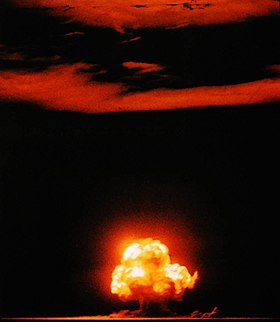
Back Trinity-kernwapentoets Afrikaans Trinity-Test ALS ترينيتي (اختبار نووي) Arabic Prueba Trinity AST Triniti (sınaq) Azerbaijani Тринити (опит) Bulgarian ট্রিনিটি (পারমাণবিক পরীক্ষা) Bengali/Bangla Trinity (assaig nuclear) Catalan Trinity (jaderný test) Czech Trinitytesten Danish
| Trinity | |
|---|---|
 The only well-exposed color photograph of the detonation of the Gadget, taken by Jack Aeby | |
| Information | |
| Country | United States |
| Test site | Trinity Site, New Mexico |
| Date | July 16, 1945 |
| Test type | Atmospheric |
| Device type | Plutonium implosion fission |
| Yield | 25 kt (100 TJ) |
| Test chronology | |
Trinity Site | |
 Trinity Site obelisk | |
| Nearest city | Bingham, New Mexico |
|---|---|
| Coordinates | 33°40′38″N 106°28′31″W / 33.67722°N 106.47528°W |
| Area | 36,480 acres (14,760 ha) |
| Built | 1945 |
| NRHP reference No. | 66000493[1] |
| NMSRCP No. | 30 |
| Significant dates | |
| Date of Nuclear Explosion | July 16, 1945 |
| Added to NRHP | October 15, 1966 |
| Designated NHLD | December 21, 1965[2] |
| Designated NMSRCP | December 20, 1968 |
Trinity was the code name of the first detonation of a nuclear weapon, conducted by the United States Army at 5:29 a.m. MWT[a] (11:29:21 GMT) on July 16, 1945, as part of the Manhattan Project. The test was of an implosion-design plutonium bomb, nicknamed "The Gadget", of the same design as the Fat Man bomb later detonated over Nagasaki, Japan, on August 9, 1945. Concerns about whether the complex Fat Man design would work led to a decision to conduct the first nuclear test. The code name "Trinity" was assigned by J. Robert Oppenheimer, the director of the Los Alamos Laboratory, possibly inspired by the poetry of John Donne.
The test, both planned and directed by Kenneth Bainbridge, was conducted in the Jornada del Muerto desert about 35 miles (56 km) southeast of Socorro, New Mexico, on what was the Alamogordo Bombing and Gunnery Range (renamed the White Sands Proving Ground just before the test). The only structures originally in the immediate vicinity were the McDonald Ranch House and its ancillary buildings, which scientists used as a laboratory for testing bomb components. Fears of a fizzle prompted construction of "Jumbo", a steel containment vessel that could contain the plutonium, allowing it to be recovered; but ultimately Jumbo was not used in the test. On May 7, 1945, a rehearsal was conducted, during which 108 short tons (98 t) of high explosive spiked with radioactive isotopes was detonated.
Some 425 people were present on the weekend of the Trinity test. In addition to Bainbridge and Oppenheimer, observers included Vannevar Bush, James Chadwick, James B. Conant, Thomas Farrell, Enrico Fermi, Hans Bethe, Richard Feynman, Isidor Isaac Rabi, Leslie Groves, Frank Oppenheimer, Geoffrey Taylor, Richard Tolman, Edward Teller, and John von Neumann. The Trinity bomb released the explosive energy of 25 kilotons of TNT (100 TJ) ± 2 kilotons of TNT (8.4 TJ), and a large cloud of fallout. Thousands of people lived closer to the test than would have been allowed under guidelines adopted for subsequent tests, but no one living near the test was evacuated before or afterward.
The test site was declared a National Historic Landmark district in 1965 and listed on the National Register of Historic Places the following year.
- ^ "National Register Information System". National Register of Historic Places. National Park Service. July 9, 2010.
- ^ "National Historic Landmarks Survey, New Mexico" (PDF). National Park Service. Archived (PDF) from the original on November 18, 2016. Retrieved December 23, 2016.
Cite error: There are <ref group=lower-alpha> tags or {{efn}} templates on this page, but the references will not show without a {{reflist|group=lower-alpha}} template or {{notelist}} template (see the help page).

